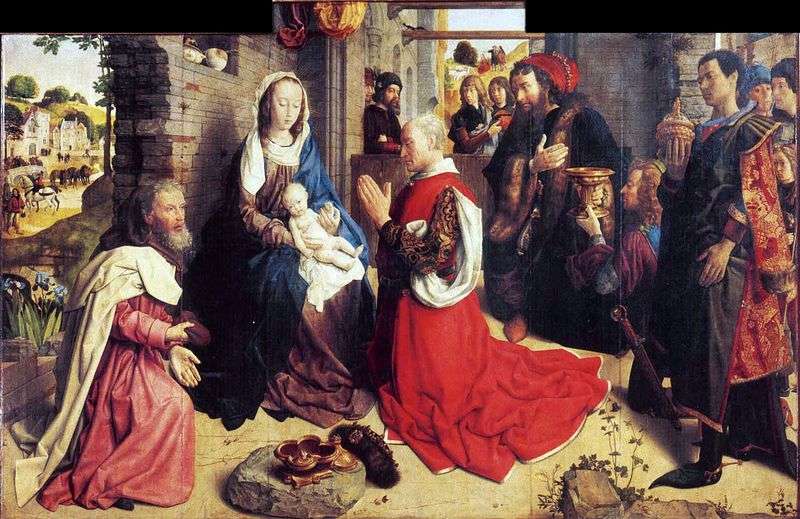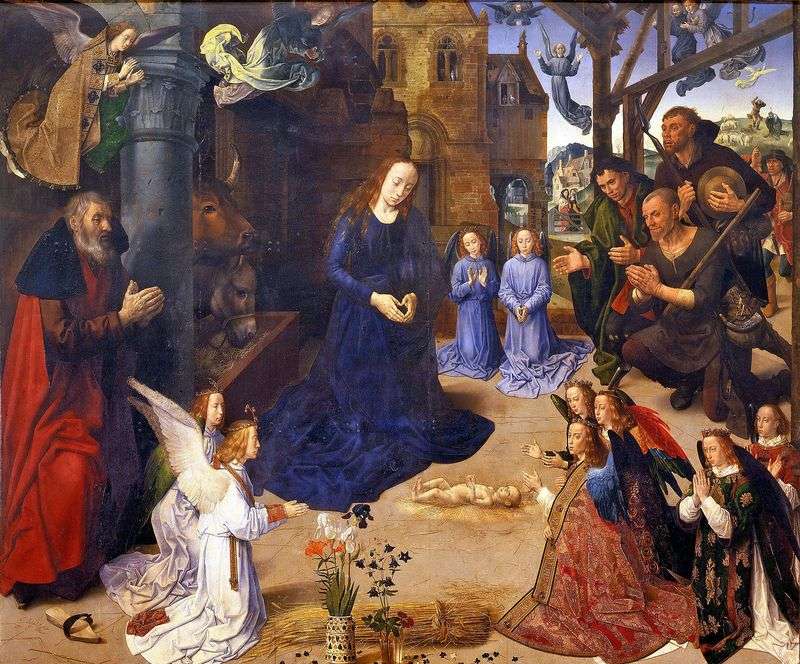
Adoration of the Magi [1468-1470] 147 x 242 cm. The State Museum, Berlin. It was suggested that Hugo van der Gus was born in the family of the Painter in Ghent. Whatever it was, he became an independent master in the local guild of artists in 1467 and worked in the city until 1477. During this decade of work in Ghent, he acquired the reputation of a highly productive artist, received numerous orders from the city and played an important role in the guild. After 1477, he unexpectedly retired to the Red Monastery near Brussels, where he died in 1482 or 1483. Like van Eyck, van der Gus stands apart from other artists: his talent is too peculiar. In a short period of creativity, he created a whole world, which even today does not seem obsolete due to the courage and sincerity of psychological characteristics and monumental pictorial vision. The Monforte altar is named so in the place of its stay before it was bought by the Berlin museum. Probably, this is one of the earliest works of the master. It was conceived as a triptych, whose length in the open state reached almost five meters, and height – two.
The leaves are not preserved, but judging by the old copies, they depicted Christmas and Circumcision of the Lord. The altar also had an outstanding section of about 70 cm; but it was almost completely sawn, possibly because of the damage. In this section, the destroyed building continued to the rafters of the roof, beneath which another angel’s choir was depicted. Since the viewpoint is low, most of the figures are viewed from the bottom. A stunning sensation of a vast space, emphasized by the chiaroscuro gestures, is literally falling upon the viewer. This is a real theatrical or, if appropriate, such a comparison, even a cinematic scene. In Christmas, van der Huss from the same museum, two prophets raise the curtain above the stage; Here, too,
In this van der Gus adopts the baton from van Eyck. But in other aspects of this early work Hugo can be seen the influence of a senior master. The black king rises above other figures like Adam in the Ghent Altar. His pose, as well as the light behind his head, are depicted in the same lively manner. The shadows on the gray floor and walls give the space a tighter aura, as in Van Eyck’s Annunciation. Heavy, but softly rounded folds of colored woolen robes are also plastic; the image of the worshiping elderly king before the Virgin Mary with the infant Christ is found only in Madonna Chancellor Rolen van Eyck. Partly thanks to this similarity, the researchers see in this figure the new Chancellor of Burgundy, Guillaume Hugone from Macon, executed by the Ghent inhabitants on suspicion of crossing over to the side of the King of France.
However, despite the beauty of the attire, it can not be considered a sufficient reason to confirm this hypothesis. As for the elderly king, although this image is a portrait, there are doubts that this is the altar donator. Only in the Gospel of Matthew is reported on the three wise men from the east, who saw the star that foreshadowed the birth of the Messiah and stopped in Jerusalem to find out the way to Bethlehem. Van der Hus interprets the tradition as it was transformed in the popular consciousness and later commentaries. He depicts the three kings as representatives of the three parts of the world. The oldest, Melchior, the European king. Caspar is Asian, and the youngest, Belshazzar, is African.
The star could be located on the lost upper section. The arrival and worship of the three kings takes place against the background of the ruins of Roman fortifications in the middle of the hilly Flemish landscape. The ruins symbolize the past biblical times before the birth of Christ. In the distance the shepherd instructs his friend to the place near the river on the left just behind the ruins. Bethlehem is located where the retinue is located with stables and other servants. Light falls on the ruins from the invisible window on the right. The Moorish king, in a red robe to the knees, embroidered with gold brocade, with a dark green tunic with a gold trim trimmed on top, holds a heavy gold-encrusted vase with a round lid, intending to present it as a gift. He is young and looks like a typical native of North Africa or Ethiopia. Like the teenager behind him, he is dressed in boots with long noses and golden spurs.
Judging by the arrogant appearance, this man, like his remaining companion in the half-darkness, is a noble official. The second king kneels, standing out with his exotic appearance. He is dressed in a black velvet jacket, richly trimmed with fur. His red and gold headpiece hangs down on his back, revealing an expressive bearded face. Being an Asian king, he looks the most theatrical. His water jar in the leather case is decorated with pearls; with his right hand he makes an expressive gesture, and the left one takes a golden vessel from the hands of a long-haired servant gracefully bent before him with a baroque appearance at the moment when his sparkling sword touches the ground. Three hands touching the vessel in themselves represent the theatrical effect and give the opportunity to demonstrate the play of light and shade. They shine as if they are in a directional beam of the searchlight.
Lighting falls on the king’s hand in such a way that her fingers appear translucent. Then a bright light glides across the cheek of a gray European king, emphasizes the relief of his large wrinkled hands, fills his scarlet raincoat, and finally his glistening freezes on the figures of the Virgin Mary, the baby Jesus and Joseph. The unpretentious pottery and wooden spoon in the niche behind Mary contrast with the richness and luxury of the gifts brought: it is enough to look at the precious cup on the large stone to which the baby Jesus looks with his clear blue eyes with almost unrestrained delight. The iris on the left is a well-known symbol of Mary’s sorrow, and the flower of the catchment on the right was at that time considered a plant of Christ.
Behind the wooden gate are other characters, among them two pages, which gaze steadily at Maria. Like a man with a black beard, they can be portraits. At the top, still visible are parts of the angelic garments. With the exception of Hugo van der Hus, not a single artist of the fifteenth century can be called a creator whose design and implementation would be so close to each other. When it becomes clear that only he was able to create a new dimension through movement and chiaroscuro in the framework of a static religious style, the pictures he created are even more filled with life before our eyes. This altar made a huge impression on the artist’s contemporaries, which is reflected in the works of Gerard David and Jan Gossaert. This indicates that the altar was still in the Netherlands, at least until the XVI century.
 The Adoration of the Shepherds (Altar of Portinari) by Hugo van der Gus
The Adoration of the Shepherds (Altar of Portinari) by Hugo van der Gus La Adoración de los Magos (Altar de Monforte) – Hugo Gus
La Adoración de los Magos (Altar de Monforte) – Hugo Gus Adoration des mages (autel de Monforte) – Hugo Gus
Adoration des mages (autel de Monforte) – Hugo Gus Adoration of the Magi. The altar of Zanobi by Sandro Botticelli
Adoration of the Magi. The altar of Zanobi by Sandro Botticelli Adoration of the Magi by Gentile da Fabriano
Adoration of the Magi by Gentile da Fabriano Adoration of the Magi by Jan Gossaert
Adoration of the Magi by Jan Gossaert The Adoration of the Magi by Albrecht Durer
The Adoration of the Magi by Albrecht Durer Adoration of the Magi by Domenico Ghirlandaio
Adoration of the Magi by Domenico Ghirlandaio